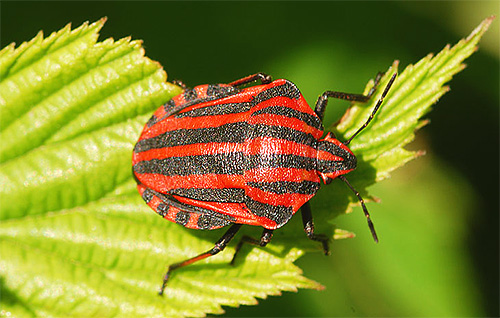
Meet the Italian Bedbug. According to the scientific classification, where Latin terminology is adopted, this insect is called Graphosoma italicum. People who saw him in his own garden came up with various pleasant and not very nicknames for him: a tiger bug or, more simply, a minke bug.
The genus of Grafosoma includes only a few species, two of which (Shitnik linear and Schitnik Italian) are so similar to each other that even entomologists argue whether to classify them as different species or to distinguish two subspecies in one species. Try to figure out whose photo is in front of you:
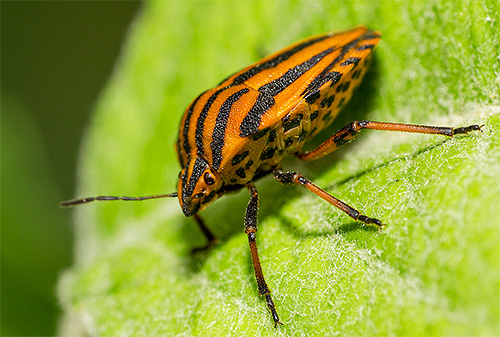
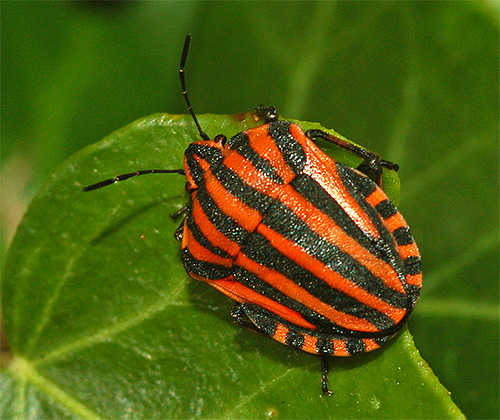
Only serious specialists can determine this, perhaps. It is believed that the color of the Italian bug is more red-orange than orange, like the subspecies Graphosoma lineatum lineatum, and its legs are black with splashes of red, and not black-red or orange. That's all that helps to recognize who is who.
Habitat of the Italian bug
The Italian bug is quite widespread. This is a heat-loving insect, but is found not only in the southern and central regions of Europe. It has also adapted well to the climatic conditions of central Russia.
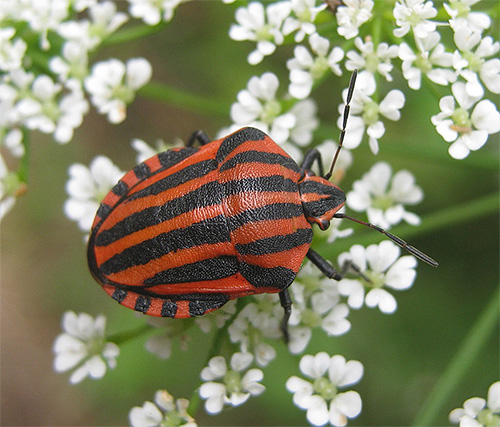
The Italian bug has long been not uncommon also for Siberian vegetable gardens, forbs of meadows, farmland and forest edges, wherever umbrella plants grow.A few years ago, Ukrainians were surprised and alarmed by the incredible growth in the number of Italian bedbugs, these beautiful insects.
The appearance of the bug
The Italian stink bug has everything that a real stink bug should have. The main attribute of representatives of the Pentatomidae family is the shield. The mesothorax of bedbugs is a dense chitinous plate, shaped like a shield. It plays the role of an exoskeleton, protects the vulnerable parts of the insect's body: abdomen, wings, internal organs.
Graphosoma scutellum lies with wide base forward, slightly narrowed posteriorly, and leaves a small part of the abdomen uncovered. Pay attention to the following photo:

The Italian bed bug really deserves admiring glances. It is an amazing red-orange color, six longitudinal black stripes are visible from above, and black spots from below, the number and location of which can vary.
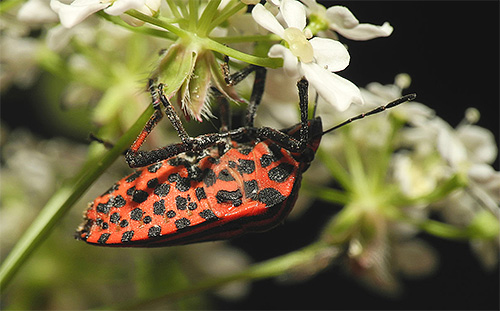
It occurred to someone that a similar combination of colors (red-orange color with dark stripes) can be seen on the uniform of the guards guarding the residence of the head of Catholicism - the Vatican. Therefore, the bug still has some, albeit indirect, relation to the Italian area.

Its daring warning coloration attracts the attention of both gardeners, anxiously guarding their crops, and potential enemies - birds and photographers. Such a noticeable instance just asks for the lens:

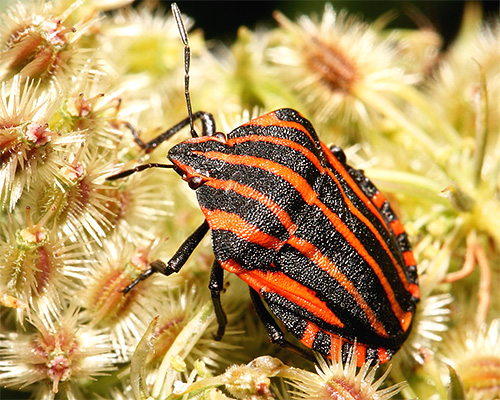
And do you know that…
Warning coloration is used intentionally by insects. It protects the wearer from natural enemies. It turns out that you can be safe not by hiding, but by deliberately exposing yourself. As a rule, those creatures that have some kind of protection look defiant. So the bugs have a very unpleasant smell, and they are inedible. The bird will not touch such an insect, and the spider will hasten to get rid of the prey that accidentally fell into its web.
The head of the Italian bug is triangular in shape, hidden up to the eyes under the pronotum. The insect, like antennae, puts forward two antennae, consisting of five segments. This is his sensitive organ. The oral apparatus of a sucking-type bug is a proboscis, which also has an articulated structure. This insect feeds exclusively on plant juices.
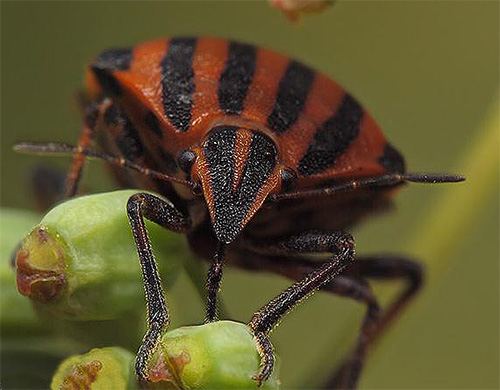
Two pairs of Italian bug wings are packed under the shield. The forewings are represented by leathery and membranous sections, on the latter longitudinal folds are distinguished. The hind wings are entirely membranous, and they keep the bug in the air.
In sunny weather, some people manage to meet the Italian bug, flying from one plant to another.But, if someone disturbs an insect peacefully sitting on a leaf, it will not rush to fly away from its chosen place. Most likely, the graphozoma will simply fall to the ground or even allow itself to be grabbed. But the offender can be sure that the bug will use its secret weapon: it will release an odorous liquid.

The Italian bug moves along the stems and leaves thanks to three pairs of tenacious paws; it easily holds onto plants swaying by the wind.
Reproduction features
The Italian bug, like all Hemiptera, goes through three stages in its development: egg, nymph, imago.

After overwintering in a soft litter of fallen leaves, the adult bug gets on the wing and goes in search of food.
When it is warm enough outside (this usually happens in May), the Italian bugs have a mating period. At this time, they gather in fairly large groups, actively feed, but here on the foliage and green shoots of plants, not really bothering to look for secluded places, fertilized females lay eggs. The laying of the shield bug is easy to recognize. Eggs are stacked in strict order: in two rows of six.
They look like miniature barrels firmly attached to the plant. At one end there is a lid from which a larva emerges, resembling the outlines of a sexually mature Italian bug, but different in color.

The rate of maturation of the embryo in the egg directly depends on the ambient temperature. The warmer it is, the faster it ripens. In hot climates, nymphs appear after 6 days, in cooler conditions this process is delayed up to a month.
The same can be said about the larvae of the Italian bug. In temperate areas, they reach sexual maturity within 25-30 days, and in the south the process is doubled.Over the summer, 2-3 generations of striped stink bugs grow up.
Is it worth it to fight the Italian bed bug?
The favorite delicacy of the Italian bug is the juices of plants of the umbrella family. He is especially attracted to seeds. Owners of personal plots, for sure, saw how the striped bug besieges dill, parsley, carrots or the ubiquitous gout.
And further: Proven methods for the destruction of bedbugs, which have shown high efficiency
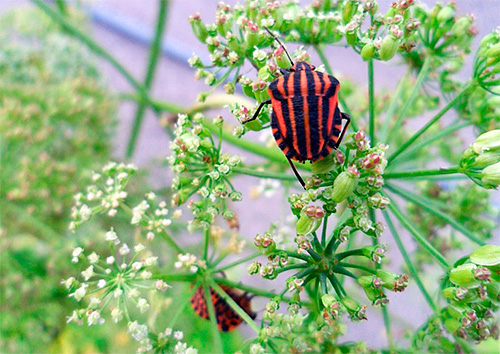
The question of whether the appearance of a bug called Italian on the beds is dangerous is being discussed. Someone considers this insect a pest that needs to be fought mercilessly. Seeds damaged by a bug dry up, fall off prematurely, and they are never destined to sprout. And other people do not see any problem in the fact that graphozoma has settled in their gardens. There is an opinion that she is very careful about the seeds, without affecting their germination.
Where is the truth? Should I take action against the Italian bug? Let's talk sensibly. Not many gardeners are engaged in independent cultivation of umbrella seeds, but the bug does not cause any damage to the plants themselves, and several individuals are not able to inflict a significant blow to the crop. First of all, it is worth getting rid of sleepiness, so as not to seduce.
If the number of shield insects has reached frightening proportions, and insects, like necklaces, hung on the bushes, and the fate of the planting material of the hosts is very disturbing, then it makes sense to fight the pest mechanically.

The Italian bug is not shy, in its bright uniform it is easily distinguishable against the background of lush greenery, and it will not be difficult at all to collect it by hand during mating. And only in exceptional cases, the help of insecticides may be needed.And here it is necessary to competently approach the choice of a chemical, without harming beneficial insects and, consequently, the future crop.






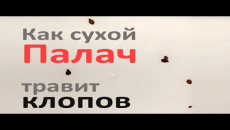
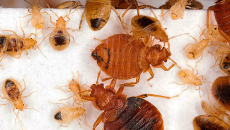

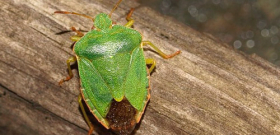

There is no information anywhere about the fight against the Italian bug with chemicals.